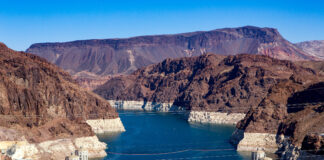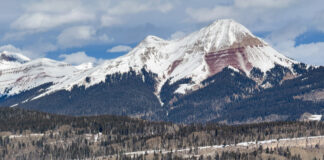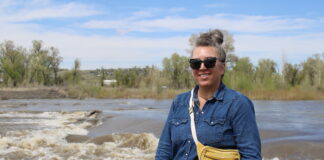
By Jane Palmer
Nevada lawmakers are considering a bold step to ensure that Las Vegas’s basic water needs will continue to be met in the near future. The Southern Nevada Water Authority (SNWA), which manages the city’s water, is seeking authority, through a sweeping omnibus bill, to cap a single family’s residential water use in southern Nevada to about 160,000 gallons (600,000 liters) annually.
Water Desk Grantee Publication
This story was supported by the Water Desk’s grants program.
“If approved, this provision would really only affect our community’s largest water users,” said SNWA spokesperson Bronson Mack—“that top 20% of residential water users who use more than 35% of all water delivered to the residential sector.”
This latest development is just one of the ways the authority has sought to protect its community’s access to water. And it’s been so successful in its mission that in the past 20 years, southern Nevada has reduced water consumption from Lake Mead by about 30%, even as the area’s population increased by more than 750,000. When the U.S. Bureau of Reclamation declared a shortage of water in the Colorado River in 2021, the region and the city handled the 25,000-acre-foot (1.2-million-liter) reduction of their water supply in 2022 with relative ease.

Despite the megadrought in the U.S. West and the fact that the Colorado River’s flow is shrinking fast, it’s been a similar story in other cities in the Colorado River Basin. Colorado Springs, Colo., a city of more than half a million, uses the same amount of water it did in the 1980s, even though its population has nearly doubled. In 2020, per capita residential water use in Tucson, Ariz., was down by about 32% from its average in 1996.
“This is a desert, and we should live like we are in a desert by being efficient with the limited water supply we have.”
The water conservation success in these basin cities has been attributed to a mix of incentives, regulations, tiered water pricing, and education. Raising awareness about water scarcity and the natural environment has proved key—especially in Las Vegas, which receives only about 4 inches (110 millimeters) of rainfall per year, said Zane Marshall, director of SNWA’s water resources department. “This is a desert, and we should live like we are in a desert by being efficient with the limited water supply we have,” he said.
Embracing the Natural Environment
Currently, 40% of Colorado’s municipal and industrial water use goes toward outdoor irrigation, and the majority of that outdoor use goes toward watering turfgrass—the thick, dense grass that carpets lawns, golf courses, sports fields, and playgrounds. But bright green grass isn’t native to Colorado.
Consequently, in Colorado Springs, the second-largest city in the state, there’s been a focus on encouraging householders and businesses to convert nearly 1.8 million square feet (168,000 square meters) of turfgrass to the natural vegetation of the landscape. Although Colorado Springs Utilities’ primary goal is to conserve water, it also strives to create an urban environment that people can enjoy.
“We want to make sure that the landscapes are healthy and attractive while providing all the ecosystem services that urban landscapes need to provide,” said Julia Gallucci, a Colorado Springs Utilities water conservation supervisor.
To that end, the utility has two Water-Wise Neighborhood demonstration gardens where they test many plant species, including 11 grasses, to determine water use and climate adaptability. Visitors can stroll through the gardens or view photos online and learn how to practice water-conscious landscaping.

In southern Nevada, the water authority has capitalized on its proximity to Lake Mead and Colorado River water. Virtually every drop of the community’s indoor water use is treated and then returned to Lake Mead. Every gallon returned acts as a credit against the region’s water allocation for the year. “It’s a unique situation in that the community’s indoor water use doesn’t negatively impact the available water supply,” Marshall said.
In Tucson, the city is using rainfall to bolster its water supply. Although, like Las Vegas, Tucson is a desert city, it receives more rainfall, mostly in the monsoon season. In 2012, Tucson Water started a program to rebate homeowners up to $2,000 for the purchase of rainwater-collecting equipment or the adoption of landscape design systems that could capture rainfall.
“It’s a way to augment the supply, while naturally the city is focusing on using less water,” said Susanna Eden, research and outreach programs officer of the University of Arizona’s Water Resources Research Center.
The idea is to integrate the harvested water with cultivating desert-adapted plants. In 2013, the city implemented a Green Streets policy, requiring that new and reconstructed roadways be designed to harvest the 10.6 inches (270 millimeters) of rainfall the city gets per year to sustain such plants near the road. “That meant that the city itself was practicing what it was advocating for other people,” Eden said.
Lessons for Future Savings
Cities account for only a fraction of the total water drawn throughout the Colorado River Basin. Eighty percent of the water in the basin feeds agriculture, and thermoelectric power and mining also withdraw some of the river’s water. Some of the lessons gleaned from urban water conservation efforts could inform other water users in the basin. For example, getting everyone to the table in water discussions and educating parties on both the crisis and possible ways forward have proved essential in the success of conserving water in southern Nevada, Marshall said.
“Efficiency is the most cost-effective source of water for us, and it will ensure that we don’t need to develop more water supplies.”
Gallucci concurred. Colorado Springs Utilities’ goal is to cultivate urban landscapes that need watering, on average, only 1 day a week. Hitting that target in the next 20 years will require education for the entire community, she said. “The switch to native vegetation is really beautiful, and it could mean less maintenance over time, but you have to have the right formula,” she said. “We don’t want people to fail because they were trying to do the right thing.”
Measuring how water is used and identifying any inefficiencies are also important in continuing to improve water conservation, whether in cities or on farmland, Gallucci said. In cities, these types of measurements need to take place from the distribution system all the way through to the customers so that every loose end, every inefficiency, can be tightened up. “Efficiency is the most cost-effective source of water for us, and it will ensure that we don’t need to develop more water supplies,” Gallucci said.
Rebates, incentives, and retrofits all cost money, but in the Colorado River Basin, it’s a case of pay now or pay later, Marshall said. So it is best to invest in water savings strategies as soon as possible. “The cost of bringing in water from elsewhere is way more expensive than conservation,” he said. “Conservation is our least expensive form of water.”
—Jane Palmer (@JanePalmerComms), Science Writer
Travel for this article was supported by The Water Desk, an independent journalism initiative based at the University of Colorado Boulder’s Center for Environmental Journalism.
The Water Desk’s mission is to increase the volume, depth and power of journalism connected to Western water issues. We’re an initiative of the Center for Environmental Journalism at the University of Colorado Boulder. The Water Desk launched in April 2019 with support from the Walton Family Foundation. We maintain a strict editorial firewall between our funders and our journalism.





